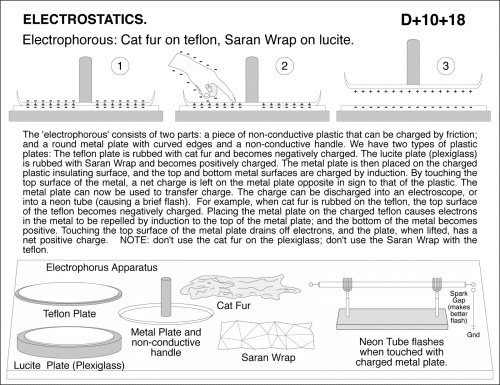Electrophorous: Cat fur on teflon, acetate on lucite.
Primary tabs
Electrophorous: Cat fur on teflon, acetate on lucite. The 'electrophorous' consists of two parts: a piece of non-conductive plastic that can be charged by friction; and a round metal plate with curved edges and a non-conductive handle. We have two types of plastic plates: The teflon plate is rubbed with cat fur and becomes negatively charged. The lucite plate (plexiglass) is rubbed with Saran Wrap and becomes positively charged. The metal plate is then placed on the charged plastic insulating surface, and the top and bottom metal surfaces are charged by induction. By touching the top surface of the metal, a net charge is left on the metal plate opposite in sign to that of the plastic. The metal plate can now be used to transfer charge. The charge can be discharged into an electroscope, or into a neon tube (causing a brief flash). For example, when cat fur is rubbed on the teflon, the top surface of the teflon becomes negatively charged. Placing the metal plate on the charged teflon causes electrons in the metal to be repelled by induction to the top of the metal plate; and the bottom of the metal becomes positive. Touching the top surface of the metal plate drains off electrons, and the plate, when lifted, has a net positive charge. NOTE: don't use the cat fur on the plexiglass; don't use the Saran Wrap with the teflon
UCB Index:
D+10+18
PIRA Index:
5A10.20
UCB Taxonomy:
PIRA Taxonomy:
Popularity:
- Log in to post comments

